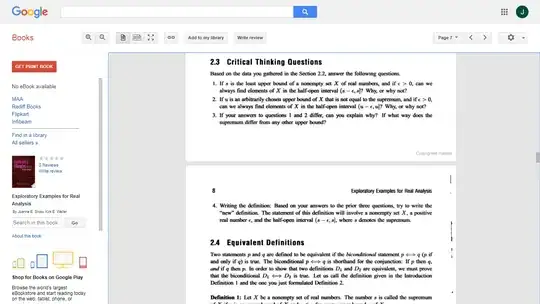Need help in vetting my answers for questions in section 2.3, 2,4 (on page # 7,8) in chap. 2 (page 7) in CRM series book by MAA: Exploratory Examples for Real Analysis, By Joanne E. Snow, Kirk E. Weller. here.
The exercises refer to my first post & second post for sec. 2.2. 
Q. 2.3:
Based on the data you gathered in Sec. 2.2, answer the following questions:
1. If $s$ is the lub of a nonempty set $X$ of real numbers, and if $ \epsilon \gt 0$, can we always find elements of $X$ in the half-open interval $(s - \epsilon, s]$. Why, or why not?
Yes, for both cases of $s$ being positive or negative, as shown below:
if $s$ is positive:
(a) $\epsilon\le s$ : Let us denote the affected lower bound of the interval by $s'=s - \epsilon$. So $s'\ge 0$, leading to $(s',s]$ being a valid interval.
(b) $\epsilon\gt s$ : So $s'\lt 0$, and $(s',s]$ still a valid interval.if $s$ is negative:
$s'\lt 0$, and $(s',s]$ still a valid interval.
It only depends on $X$ if it has elements in the given interval. This is particularly relevant for non-continuous sets.
- If $u$ is an arbitrarily chosen upper bound of $X$, i.e. not equal to the supremum, and if $\epsilon \gt 0$, can we always find elements of $X$ in the half-open interval $(u - \epsilon, u]$. Why, or why not?
(i) Consider the lower bound : Only if $u-s \lt \epsilon$.
Let $u-s = k.\epsilon, k\lt 1$, then
$u-s= k.\epsilon \implies u = s+k.\epsilon \implies u -\epsilon = s+(k-1).\epsilon \implies u -\epsilon \lt s$.
(ii) Consider the upper bound : The upper bound of the interval $(u - \epsilon, u]$ is $u \gt s$.
This ensures that $\exists x \in X$ for $(u - \epsilon, u]$.
- If your answers to questions 1 & 2 differ, can you explain why? In what way, does the supremum differ from any other bound.
supremum is the least upper bound that may lie in the set. No $\epsilon \gt 0$ can exclude elements of range from the interval $(s - \epsilon, s]$.
But, any other upper bound (let, $u\gt s$) must have $(u - \epsilon\lt s]$ to have any element of the set in the interval $(u - \epsilon, u]$.
- Writing the definition: Based on your answers to the prior three questions, try to write "new" definition. The statement of this definition will involve a nonempty set $X$, a positive real number $\epsilon$, & the half-open interval $(s - \epsilon, s]$, where $s$ denotes the supremum.
Let there be a nonempty set $X$ with supremum $s$, then $X\cap(s - \epsilon, s]\ne \emptyset, \,\, \forall \epsilon\gt 0$.
Q. 2.4:
Two statements $p,q$ are said to be equivalent if the biconditional statement $p \iff q$ ($p$ if and only if $q$) is true. The biconditional $p \iff q$ is shorthand for the conjunction: $\cdots$Definition 1: Let $X$ be a nonempty set of real numbers. The number $s$ is called the supremum of $X$ if $s$ is an upper bound of $X$ and $s \le y$ for every upper bound of $X$.
Definition 2: This is the "new" definition you derived in Sec. 2.3.
In order to show that the two definitions are equivalent, we must prove the following two conditional statements:
(i) If $s = sup(X)$, as given by Defn. 1, then $s$ is the supremum, as given by Defn. 2. Here, assume that Defn. 1 holds, and use this assumption to prove that Defn. 2 holds.
Let $s'$ is supremum as per Defn. 2. Also, the relation between the magnitudes of $s,s'$ is unknown, & need be established.
This implies : supremum $s$ will have set $X$ elements in the range $(s-\epsilon, s]$ if $s-s' \lt \epsilon$, by the below proof:
Let $s-s' = k.\epsilon, k\lt 1$, then $s-s'= k.\epsilon \implies s = s'+k.\epsilon \implies s -\epsilon = s'+(k-1).\epsilon \implies s -\epsilon \lt s'$. This keeps lower bound $\lt s'$, ensuring that $\exists x \in X: X\cap (s - \epsilon, s]\ne \emptyset$.
But, Def. 2 can take any $\epsilon\gt 0$.
So, if Def. 1 is to have ability to take any $\epsilon\gt 0$, need the lower bound of $(s - \epsilon, s]$ to equal at least to $s' - \epsilon$.
But, $s - \epsilon= s'+(k-1)\epsilon \ge s- \epsilon, \forall k, 0\lt k\lt 1$.
So, the only possible value is $k=0$ to have the lower bound of $(s - \epsilon, s]$ equal to $s' - \epsilon$.
But, by this cannot impose any restriction on the upper bound $s$ (of Def. 1) to equal $s'$ (of Def. 2).
(ii) If $s = sup(X)$, as given by Defn. 2, then $s$ is the supremum, as given by Defn. 1. Here, assume that Defn. 2 holds, and use this assumption to prove that Defn. 1 holds.
Let us modify for consistency with part (i) sake, $s$ replaced by $s'$.
If Defn. 2 holds, then the upper bound of the interval is bounded by $s'$, which is also the last element that can possibly be (if, $s'\in X$) in $X$. For Defn. 1 to hold, the upper bound must then be the same as the upper bound of Defn. 2, i.e. $s'$.
What is the practical significance of showing that these two definitions are logically equivalent?
The step (i) of showing that if Defn. 1 holds, then Defn. 2 holds, leads to having the lower bound of $(s - \epsilon, s]=s' - \epsilon$.
The step (ii) of showing that if Defn. 2 holds, then Defn. 1 holds, leads to having the upper bound of $(s - \epsilon, s]=s'$.
